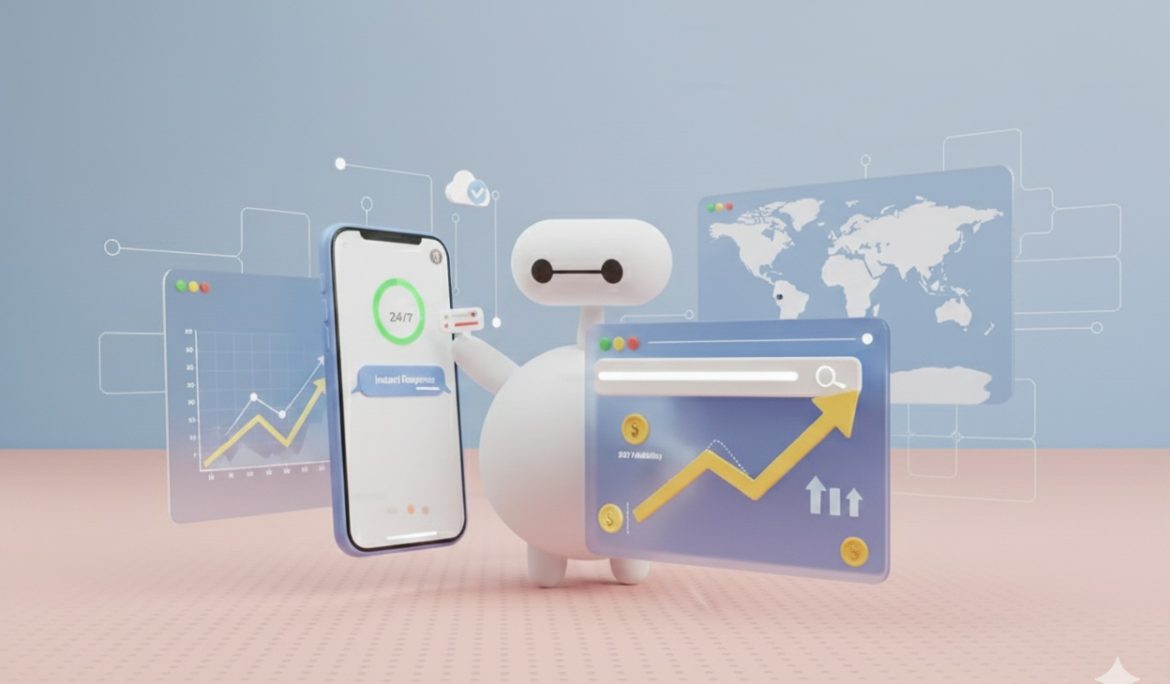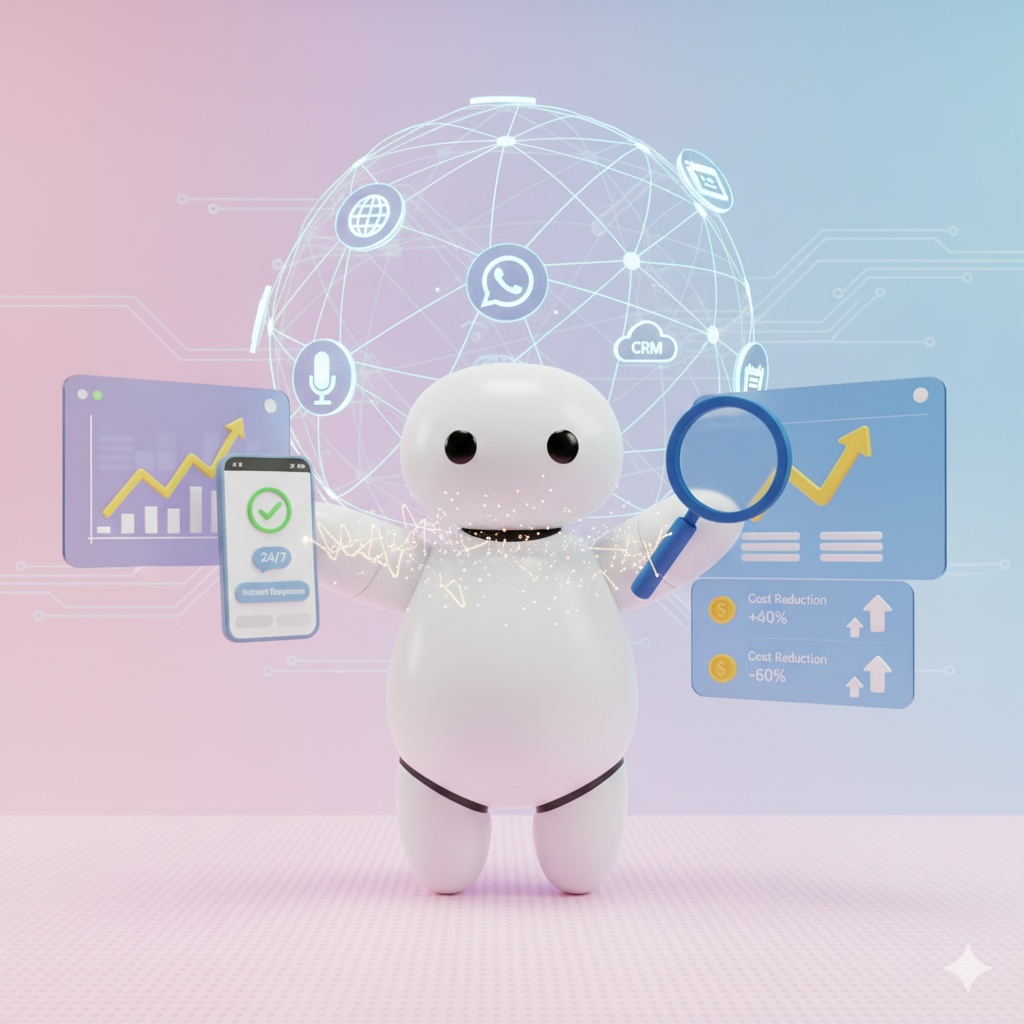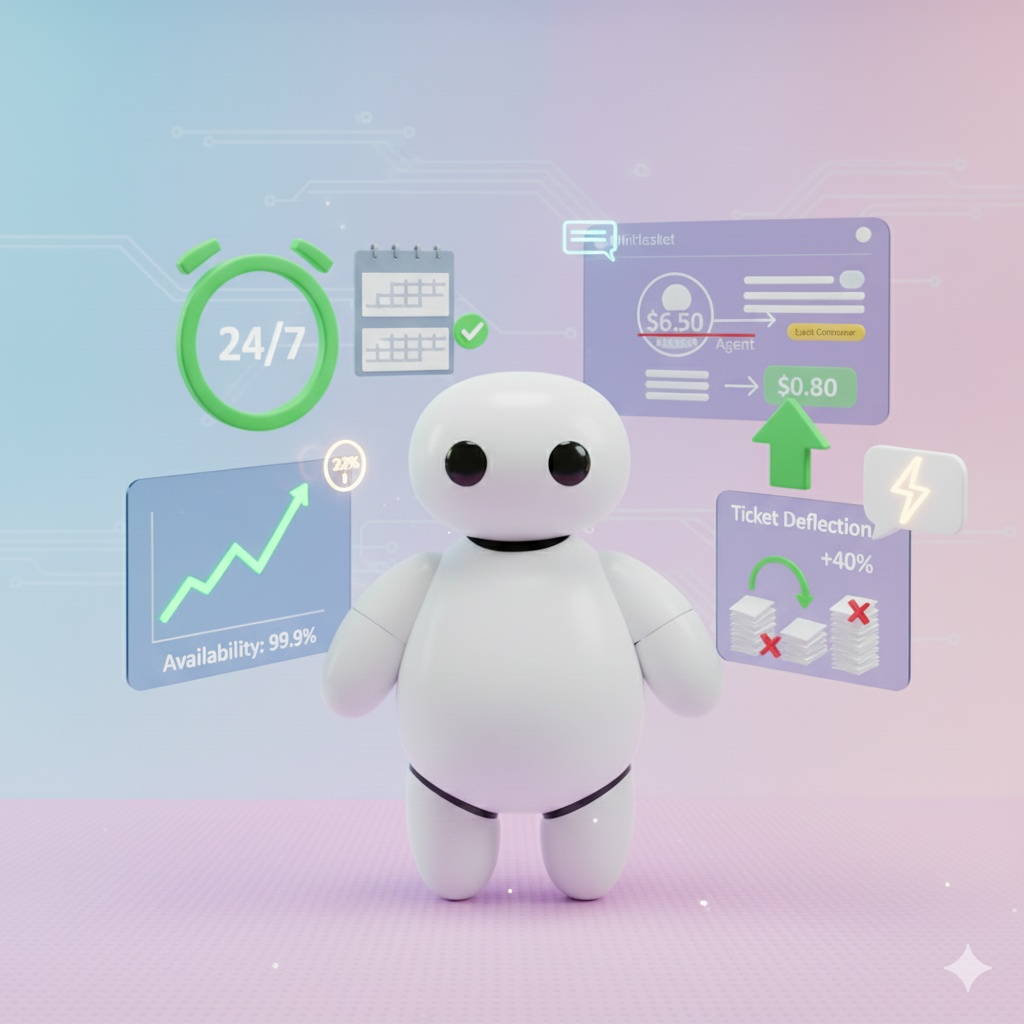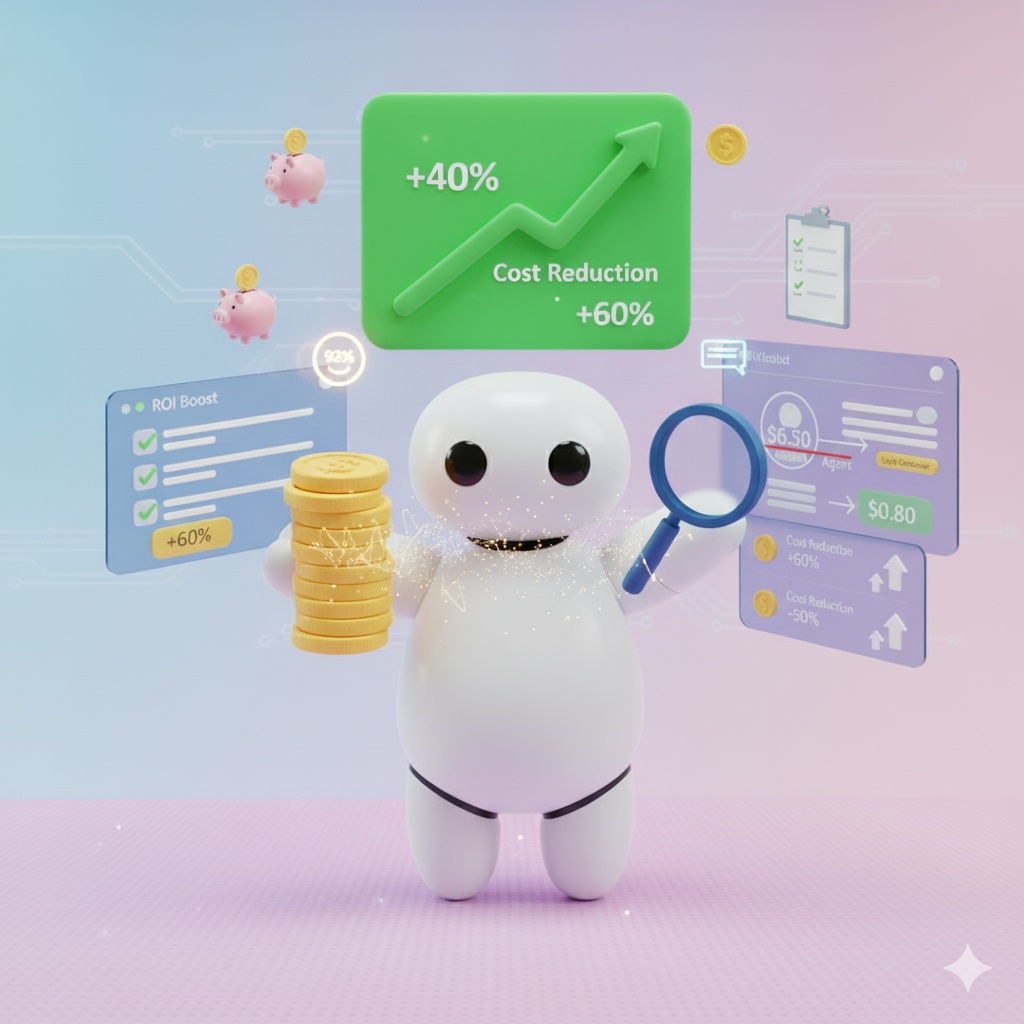
Introduction: Why AI Chatbots Are No Longer “Nice-to-Have”
Customer expectations have changed. In 2025, people don’t just want quick answers; they expect instant, personalized, and frictionless experiences across every touchpoint. For businesses, this means customer support can no longer be handled by humans alone.
AI-powered chatbots, once experimental, are now at the core of customer service strategies. These bots are built on advanced GPT-based models that understand natural language, context, and intent better than ever before.
Consider these numbers:
- 68% of customers say they prefer chatbots for quick answers.
- Companies report a 40% drop in average resolution time after implementing AI chatbots.
- In Dubai, Mumbai, London, and New York, enterprises now allocate up to 25% of customer support budgets to AI integration.
For decision-makers, the question isn’t “Should we use AI chatbots?” anymore. It’s “How do we implement them correctly and prove ROI?”
This guide will walk you through:
- How to implement AI-powered chatbots for customer support.
- Best practices for configuration in 2025.
- How to calculate ROI (with formulas and examples).
- Key trends shaping chatbot performance.
- Real-world case studies showing ROI in action.

Why AI-Powered Chatbots for Customer Support Matter in 2025
1. Cost Savings at Scale
Traditional support centers rely on human agents, but scaling this model is expensive. AI chatbots reduce cost per interaction from $5–12 (human agent) to $0.50–1.00 (AI bot).
2. 24/7 Availability
Customers don’t wait for business hours. A chatbot ensures support across time zones, with no staffing issues.
3. Ticket Deflection & Agent Efficiency
AI bots handle FAQs, order tracking, password resets, and product queries, freeing human agents for complex issues. Studies show 30–60% of tickets can be automated.
4. Enhanced User Experience
Unlike early bots that frustrated users, 2025 AI chatbots can:
- Detect intent and emotion.
- Escalate to humans when needed.
- Personalize answers based on CRM and past interactions.
5. Competitive Advantage
With 6.8 million apps and countless websites competing for attention, customer support chatbots are a key differentiator. A seamless, AI-enhanced support system boosts customer loyalty and retention.
Before & After Snapshot: Impact of AI Chatbots
| Metric | Before Chatbot | After an AI-Powered Chatbot |
| Average Cost Per Interaction | $6.50 | $0.80 |
| First Response Time | 4+ minutes | Instant (<2 sec) |
| Ticket Resolution Rate | 55% human-only | 80% with AI assist |
| Customer Satisfaction (CSAT) | 72% | 87% |
| Agent Workload | 100% manual | 40% reduced |
This clear ROI is why AI-powered chatbots for customer support are among the top 3 technology investments in 2025.
Implementation Roadmap: How to Deploy AI-Powered Chatbots in 2025
Deploying a chatbot is not about installing a plugin; it’s about strategic integration into your business processes. Below is the step-by-step implementation roadmap, adapted for the technologies and customer expectations of 2025.

Step 1: Define the Chatbot’s Purpose
Before touching any tools, clarify:
- What role will the chatbot play? (FAQ bot, lead gen assistant, full-service support).
- What KPIs matter? (Reduced support costs, higher CSAT, faster response).
- Who is the primary audience? (New customers, existing users, enterprise clients).
📌 Example:
An e-commerce brand in Dubai defined its chatbot’s purpose as “reducing repetitive queries around order tracking and returns.” Within three months, 48% of queries were handled without human agents.
Step 2: Choose the Right AI Model & Platform
In 2025, businesses will have options beyond generic bots:
- GPT-based large language models (LLMs) for advanced natural language understanding.
- Domain-specific fine-tuned models for industries like banking (compliance-focused) or healthcare (HIPAA-ready).
- Multimodal bots that can process text, voice, and even images (e.g., scanning a medical bill or product barcode).
📌 Case Study (Healthcare):
A telehealth startup in India deployed a chatbot trained on medical FAQs + their internal knowledge base. It reduced triage time by 35% and increased doctor availability for critical cases.
Step 3: Map Customer Journeys
Outline where customers interact with your brand:
- Website (product pages, checkout).
- Mobile app.
- WhatsApp, Messenger, or Telegram.
- Call center IVR integration (voice bots).
Each touchpoint requires different intents, tone, and depth of responses.
📌 Case Study (Banking):
A UAE-based bank integrated its chatbot into mobile banking + WhatsApp. Customers used it for balance checks, transaction status, and card blocking. It handled 62% of daily queries, saving 1,000+ agent hours monthly.
Step 4: Integrate with Backend Systems
A chatbot becomes powerful when it connects to:
- CRM (HubSpot, Salesforce) for customer history.
- ERP systems for order/inventory details.
- Helpdesk platforms (Zendesk, Freshdesk) for escalation.
- Knowledge bases + CMS for instant answers.
Without integrations, a chatbot risks being just a “glorified FAQ.”
Step 5: Configure Conversational Flows
Modern AI chatbots are flexible, but guided flows still matter for accuracy.
- Define intents (refund request, password reset, delivery status).
- Write fallback responses to avoid “Sorry, I didn’t get that.”
- Add human handoff rules for complex queries.
📌 Best Practice: Use decision trees for common paths + AI freeform responses for open-ended queries.
Step 6: Train and Fine-Tune the Chatbot
- Upload historical chat logs, FAQs, and manuals.
- Continuously feed new scenarios and updates.
- Use few-shot training: give the AI 3–5 examples per intent for accuracy.
📌 Example:
An online electronics retailer trained its chatbot on past refund requests. After tuning, the refund query resolution accuracy jumped from 61% → 92%.
Step 7: Test in Controlled Environments
Testing ensures a smooth launch.
- Internal Beta: Employees interact with the bot to find gaps.
- Soft Launch: Release to 10–20% of customers.
- Full Launch: After fixing critical issues.
📌 Pro Tip: Use A/B testing – run bot vs. human on the same task and compare speed + satisfaction.
Step 8: Deploy Across Channels
In 2025, customer support chatbots will be omnichannel.
- Web + App (widget/chatbox).
- WhatsApp (most used in the UAE + India).
- Voice (call center AI assistants).
- Social media integrations.
This ensures consistent brand support everywhere.
Step 9: Monitor Key Metrics
After launch, track:
- Deflection rate (% tickets solved by bot).
- Cost per interaction (AI vs human).
- Customer satisfaction (CSAT/NPS).
- Average handling time (AHT).
- Escalation rate (% of chats needing human support).
📊 Example Benchmark:
- Target deflection: 30–50%.
- CSAT boost: +15–20%.
- Cost savings: 40% average per year.
Step 10: Continuous Improvement
AI chatbots are never “done.”
- Update the knowledge base weekly.
- Add new intents as business evolves.
- Train with real user conversations.
- Optimize for Core Web Vitals to ensure performance.
📌 Emerging 2025 Trend: Some chatbots now self-learn by analyzing log files and adapting flows autonomously.

ROI Calculation Framework for AI-Powered Chatbots in 2025
When businesses ask about AI-Powered Chatbots for Customer Support, the #1 question is:
👉 “How much money will this save us?”
In 2025, the ROI of customer support chatbots isn’t theoretical anymore; it’s measurable. Companies that implemented AI chatbots report:
- 30–50% reduction in support costs.
- 40% faster response times.
- +20% improvement in CSAT (Customer Satisfaction Scores).
Here’s the detailed ROI framework businesses can apply.
1. Cost per Interaction
- Human agent interaction cost (2025 avg): $4–$6 per chat/email.
- AI chatbot interaction cost: ~$0.50–$1.50 (hosting + training).
📊 Impact: A company handling 50,000 monthly queries can save $150,000+ annually just by automating Tier-1 support.
2. Ticket Deflection Rate
This measures how many customer requests are resolved by the chatbot without human intervention.
- Average benchmark in 2025: 30–60% deflection.
- Higher with FAQ-heavy industries (e-commerce, travel, banking).
📌 Example:
An airline deflected 45% of boarding pass & baggage queries, freeing agents for urgent cases.
3. Agent Time Saved
- Pre-chatbot: Agents spend ~5 minutes per ticket.
- Post-chatbot: Chatbot resolves 60% instantly, while escalated cases reach agents pre-filtered (saving 2 minutes per case).
For 10,000 monthly tickets, this saves 333+ agent hours/month.
4. Customer Satisfaction (CSAT)
Chatbots boost CSAT by providing:
- 24/7 instant answers.
- Consistent tone & accuracy.
- Reduced wait times.
2025 Benchmark:
- Avg CSAT with chatbots: 85–90%.
- Avg CSAT without chatbots: 70–75%.
5. Conversion Lift
AI chatbots aren’t only for support; they act as sales assistants.
- Recommend products.
- Upsell/cross-sell.
- Recover abandoned carts.
📊 Case Study:
A Dubai fashion e-commerce store added an AI bot at checkout → 12% lift in conversions within 3 months.
ROI Formula
Here’s a simple way to calculate ROI:
ROI=(Cost Savings+Revenue Lift)−InvestmentInvestment×100ROI = \frac{(Cost\ Savings + Revenue\ Lift) – Investment}{Investment} \times 100ROI=Investment(Cost Savings+Revenue Lift)−Investment×100
Where:
- Cost Savings = (Tickets handled by AI × Cost per human interaction) – (Tickets handled by AI × Cost per bot interaction).
- Revenue Lift = Additional sales from chatbot-driven conversions.
- Investment = AI platform subscription + setup + training costs.
ROI Before vs. After: Small Business vs. Enterprise
| Metric | Small Business (10K queries/mo) | Enterprise (200K queries/mo) |
| Human Agent Cost (avg $5/chat) | $50,000/mo | $1,000,000/mo |
| Chatbot Handling 50% Queries | 5,000 chats → $25,000 saved | 100,000 chats → $500,000 saved |
| Bot Cost ($1/chat avg) | $5,000 | $100,000 |
| Net Monthly Savings | $20,000 | $400,000 |
| Annual Net Savings | $240,000 | $4.8M |
| Additional Revenue Lift (upsell) | +$25,000/yr | +$1M/yr |
| CSAT Improvement | 72% → 88% | 70% → 90% |
| Agent Time Saved | 833 hrs/yr | 16,000+ hrs/yr |
✅ Even small businesses save 6 figures/year, while enterprises save millions with chatbots.
2025 ROI Benchmarks
- Break-even point: Most businesses recover chatbot investment in 3–6 months.
- Long-term impact:
- Lower churn due to better support.
- Higher customer loyalty (repeat purchases).
- Scalable growth without hiring more agents.
Challenges, Solutions & Future Trends of AI-Powered Chatbots in 2025
Even though AI-Powered Chatbots for Customer Support deliver huge ROI, companies still face hurdles when deploying them. The good news? In 2025, solutions exist for most challenges.
🔴 Common Challenges & ✅ Practical Solutions
1. Integration with Legacy Systems
- Challenge: Older CRMs, ticketing systems, or ERPs often struggle to connect with AI chatbots.
- Solution: Use middleware APIs (Zapier, Make, custom APIs) to bridge systems. Many 2025 chatbot platforms now provide native integrations with Salesforce, Zendesk, HubSpot, and SAP.
2. Data Privacy & Compliance
- Challenge: Handling sensitive data (healthcare, finance) requires strict compliance (GDPR, Dubai Data Law, HIPAA).
- Solution:
- Configure chatbots to mask personal data in logs.
- Host data in region-specific servers (Dubai businesses often require UAE-based servers).
- Add AI transparency notices to inform customers when they’re speaking to a bot.
3. User Trust & Expectations
- Challenge: Customers get frustrated if bots feel “too robotic” or fail often.
- Solution:
- Implement hybrid chat support: AI handles Tier-1 queries, agents step in for complex cases.
- Train bots with industry-specific vocabulary (e.g., banking, travel, healthcare).
- Add a human fallback, a button like “Talk to an agent” always available.
4. Maintenance & Continuous Learning
- Challenge: Bots become outdated if they don’t learn new FAQs, policies, or product details.
- Solution:
- Connect bots to a central knowledge base that auto-updates.
- Run monthly performance audits → fix high-failure queries.
- Use feedback loops: when users click “This didn’t help”, the bot logs it for training.
5. Multilingual & Cultural Barriers
- Challenge: Dubai’s market has 200+ nationalities, so English-only bots fail to serve everyone.
- Solution:
- Deploy multilingual chatbots (Arabic, English, Hindi, Urdu, Tagalog).
- Use AI translation (DeepL, Google AI Translate APIs).
- Localize tone → Arabic bots use a more formal style, English bots a more casual one.
Future Trends in AI Chatbots (2025 and Beyond)
1. Voice AI Becomes Standard
- By 2025, 50% of chatbot interactions will be voice-based.
- Example: Banks in Dubai allow customers to check balances via WhatsApp voice chatbots.
- Business tip: Invest in voice + text chatbots for omni-channel support.
2. Autonomous AI Agents
- Instead of just answering, bots act on behalf of customers.
- Example: An Airline chatbot not only checks flight status but also reschedules flights automatically.
- 2025 Tech: Powered by multi-step reasoning models and workflow automation.
3. Hyper-Personalization with AI
- Chatbots use past purchase history, browsing behavior, and preferences to tailor responses.
- Example: An e-commerce chatbot remembers your shoe size and recommends new arrivals automatically.
- ROI: Personalized chatbots can increase upsells by 25%.
4. Multimodal Interactions
- Beyond text → bots now handle images, documents, and even AR support.
- Example: A Car insurance bot in Dubai lets customers upload accident photos, then auto-generates a claim report.
Mini Case Study: Dubai Retail Business Using AI Chatbots
Client: Mid-sized fashion retailer in Dubai.
Problem: Customer service team overloaded with 8,000+ monthly inquiries (order tracking, returns, size queries).
Solution: Implemented AI-Powered Chatbot with WhatsApp + Website integration in 2024.
Before Implementation:
- Avg response time: 20 minutes.
- CSAT: 74%.
- Cost: $40,000/year for agents.
After Implementation (6 months):
- Response time: Instant (24/7).
- CSAT: 89%.
- Cost savings: $25,000/year.
- Sales lift: 8% increase due to personalized product recommendations.
✅ ROI Achieved: 4.2X within first year.
Before vs After Table
| Metric | Before Chatbot | After Chatbot (6 Months) |
| Avg Response Time | 20 min | Instant |
| Customer Satisfaction (CSAT) | 74% | 89% |
| Agent Cost | $40,000/yr | $15,000/yr |
| Net Annual Savings | — | $25,000 |
| Additional Revenue | — | +8% sales uplift |
Decision Framework for AI-Powered Chatbots in 2025
Not every business needs the same chatbot strategy. Here’s a quick framework to decide:
1. Business Size & Customer Volume
- Small Business (<1,000 queries/month): Start with a basic FAQ chatbot (website only).
- Mid-Sized (1k–10k queries/month): Deploy AI chatbot with human fallback (website + WhatsApp).
- Enterprise (10k+ queries/month): Use a multi-channel AI agent with integrations (CRM, ERP, voice).
2. Primary Goals
- Cost Reduction → Automate Tier-1 FAQs (billing, tracking).
- Customer Experience → Personalize responses, multilingual support.
- Revenue Growth → Use chatbots for upselling/cross-selling.
3. Budget & ROI Expectation
- Entry-level: $200–$500/month (cloud-based AI chatbots).
- Mid-tier: $1,000–$5,000/month (custom integrations + multilingual).
- Enterprise: $10k+/month (full AI agent ecosystem).
AI Chatbot Implementation Checklist (25 Steps)
Here’s a condensed roadmap:
Planning
- Define chatbot goals (support, sales, engagement).
- Map customer journeys.
- List FAQs and common tickets.
- Choose chatbot type (rule-based vs AI).
- Decide supported channels (web, WhatsApp, app).
Setup & Configuration
- Select platform (Dialogflow, Azure, GPT APIs).
- Train bot with FAQs + past chat data.
- Configure fallback to human agents.
- Set bot tone (formal, casual, multilingual).
- Integrate with CRM/helpdesk.
Testing & Deployment
- Run a closed beta with staff.
- Test edge cases (angry users, typos).
- Stress test with high volumes.
- Optimize for mobile-first UX.
- Deploy in stages (FAQ first, then advanced).
Optimization
- Monitor success rate (resolved queries %).
- Track ticket deflection rate.
- Measure CSAT and NPS scores.
- Add personalization features.
- Train the bot monthly with new queries.
Scaling & Future-Proofing
- Add voice support.
- Enable image/document handling.
- Connect payment gateways for transactions.
- Expand to multiple languages.
- Run quarterly ROI analysis.
📥 Pro Tip: Turn this into a Downloadable PDF “AI Chatbot Playbook 2025” as a lead magnet.
❓ FAQs: AI-Powered Chatbots in 2025
Q1: How much does an AI-powered chatbot cost in 2025?
A: Entry-level bots cost $200–$500/month, while enterprise AI chatbots with CRM + voice support can cost $10,000+/month.
Q2: How long does it take to implement?
A: A simple FAQ bot takes 1–2 weeks. Full AI chatbot integration with CRM and multilingual features takes 2–3 months.
Q3: Do chatbots replace human agents?
A: No. They reduce Tier-1 repetitive queries (40–60%), but humans still handle complex cases.
Q4: What ROI can we expect?
A: Most businesses see 2–4X ROI in the first year through cost savings + increased conversions.
Q5: Are chatbots safe for sensitive industries like banking or healthcare?
A: Yes, if configured properly with data masking, on-premise servers, and compliance with GDPR/HIPAA/Dubai Data Law.
Conclusion
By 2025, AI-Powered Chatbots for Customer Support are no longer optional; they’re a competitive necessity.
- They cut support costs by up to 60%.
- They boost customer satisfaction by 20%+.
- They increase conversions with personalization.
👉 Whether you’re a startup in Dubai, a mid-sized e-commerce store, or an enterprise bank, the path is the same:
- Start small, measure ROI, scale with confidence.
📌 Next Step:
Get a free AI chatbot audit → we’ll review your customer support setup, suggest automation opportunities, and estimate ROI within 7 days.